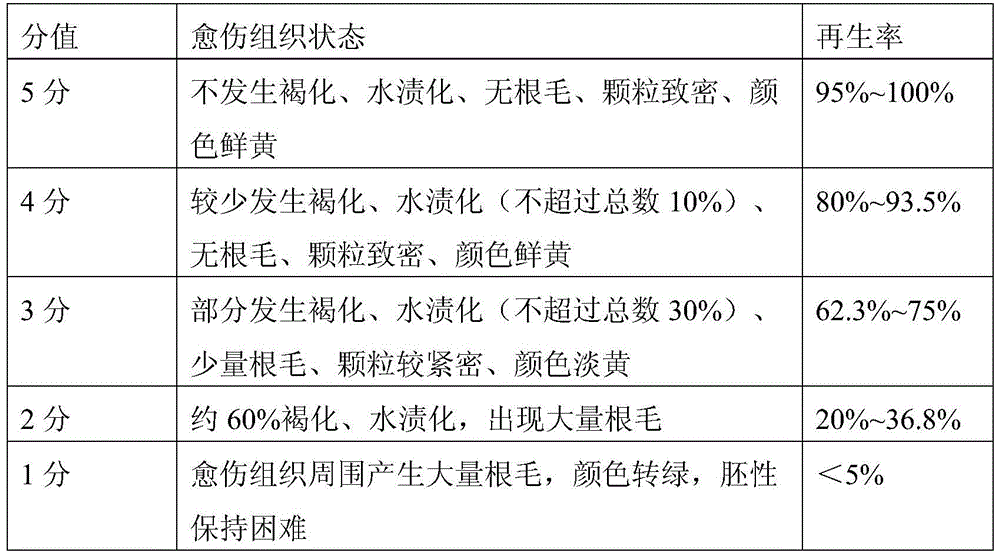A Method for Effectively Preserving Embryogenic Callus of Calamus Iris
A technique for embryogenic callus and callus, which is applied in the field of effectively preserving embryogenic callus of A. calamus, can solve the problems of difficulty in later preservation and proliferation, poor embryogenicity of callus, loss of plant mother, etc. Differentiation and differentiation, easy operation, good effect of callus embryo
- Summary
- Abstract
- Description
- Claims
- Application Information
AI Technical Summary
Problems solved by technology
Method used
Image
Examples
Embodiment 1
[0032] Step 1: Material collection:
[0033] Take the well-developed capsule (7-10cm in length) 50 days after the flowering stage of Iris japonica, put it in a sealed bag and refrigerate it in a refrigerator at 4°C for 4 days, then soak it in tap water with detergent and a small amount of TWEEN-20 for about 20 minutes , and then rinsed under running water for 40 minutes, and then sterilized on the ultra-clean workbench; after the capsules were immersed in an alcohol solution with a volume concentration of 70%, they were burned on the flame of an alcohol lamp until the alcohol on the surface of the capsules was completely volatilized.
[0034] Step 2: callus induction culture:
[0035] Place the sterilized capsules in step 1 on the high-temperature sterilized filter paper, cut them along the longitudinal edge of the fruit with tweezers and a scalpel, take out the full-grained seeds and put them on the sterile filter paper, peel off the white tender embryos and inoculate On the...
Embodiment 2
[0042] Step 1: Material collection:
[0043] Take the well-developed capsule (7-10cm in length) 50 days after the flowering stage of Iris japonica, put it in a sealed bag and refrigerate it in a refrigerator at 4°C for 4 days, then soak it in tap water with detergent and a small amount of TWEEN-20 for about 20 minutes , and then rinsed under running water for 40 minutes, and then sterilized on the ultra-clean workbench; after the capsules were immersed in an alcohol solution with a volume concentration of 70%, they were burned on the flame of an alcohol lamp until the alcohol on the surface of the capsules was completely volatilized.
[0044] Step 2: callus induction culture:
[0045] Place the sterilized capsules in step 1 on the high-temperature sterilized filter paper, cut them along the longitudinal edge of the fruit with tweezers and a scalpel, take out the full-grained seeds and put them on the sterile filter paper, peel off the white tender embryos and inoculate On the...
Embodiment 3
[0051] Step 1: Material collection:
[0052] Take the well-developed capsule (7-10cm in length) 50 days after the flowering stage of Iris japonica, put it in a sealed bag and refrigerate it in a refrigerator at 4°C for 4 days, then soak it in tap water with detergent and a small amount of TWEEN-20 for about 20 minutes , and then rinsed under running water for 40 minutes, and then sterilized on the ultra-clean workbench; after the capsules were immersed in an alcohol solution with a volume concentration of 70%, they were burned on the flame of an alcohol lamp until the alcohol on the surface of the capsules was completely volatilized.
[0053] Step 2: callus induction culture:
[0054] Place the sterilized capsules in step 1 on the high-temperature sterilized filter paper, cut them along the longitudinal edge of the fruit with tweezers and a scalpel, take out the full-grained seeds and put them on the sterile filter paper, peel off the white tender embryos and inoculate On the...
PUM
 Login to View More
Login to View More Abstract
Description
Claims
Application Information
 Login to View More
Login to View More - R&D
- Intellectual Property
- Life Sciences
- Materials
- Tech Scout
- Unparalleled Data Quality
- Higher Quality Content
- 60% Fewer Hallucinations
Browse by: Latest US Patents, China's latest patents, Technical Efficacy Thesaurus, Application Domain, Technology Topic, Popular Technical Reports.
© 2025 PatSnap. All rights reserved.Legal|Privacy policy|Modern Slavery Act Transparency Statement|Sitemap|About US| Contact US: help@patsnap.com


